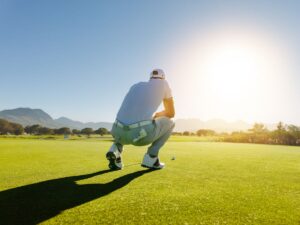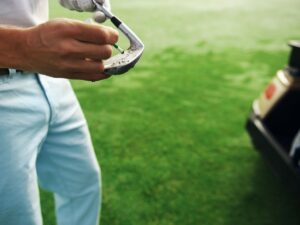
How Does a Golf Rangefinder Work?

- Last Updated on
Contents
Did you know that laser rangefinders aren’t a new invention at all?
According to Blue Tees Golf, “The very first rangefinder was developed by a Scottish company called Barr and Stroud in the 1880s. It wasn’t until World War II when the first electronic rangefinder was used.”
However, they didn’t gain a ton of popularity in the golf industry until the 2000s. But professional golfers started using them during practice rounds in the late 1990s. Now, they’re a staple for almost every golfer as they make the game so much easier.
But how does a golf rangefinder work? How can a small device provide the distance to a bunker or flag in milliseconds?
Keep reading to learn more about these devices, the different types of rangefinders, and other ways they can help your game.
How Does a Rangefinder Work?
Rangefinders have changed the game of golf.
Before these digital devices golfers had to look for 150 yard stakes, pace off from sprinkler heads, and guess on a lot of distances. But now, you can easily laser a flag (or hazard) to see the exact distance.
Rangefinders are great because they:
- Help speed up pace of play.
- Identify water, out of bounds, and sand on your tee shot.
- Make it easy to get a distance to the flag for every approach shot.
- Create a strategy for the hole if you’ve never played the course before.
Simply point the device at the target, tap the button, and get instant information about the shot you’re faced with.
But how does a rangefinder work anyway?
It depends on the type of rangefinder you’re using…

- True Hybrid GPS/Laser Rangefinder
- GPS Pin Assist: Utilizes GPS Data to Filter Background and Hone in on the Pin
- Color Touch LCD Screen
- 2 Color OLED for Low Light Play
- Course layout/ GPS yardage view Green Undulation, Course Layout View
- Included components: Charging Cable

- Precise Slope Measurement: Highly accurate laser rangefinder accounts for elevation changes and measures the angle of incline/decline
- Maximum Magnification: Equipped with 6x magnification
- Pin-Locking Technology
- Pulse Confirmation: Emits a short vibrating "burst" when the laser locks onto the pin to confirm you have the correct distance

- Most accurate laser range finder on the market within 10” of the flag
- Image stabilization makes it easier to find and range the flag for precise distances to the pin
- Vibrational feedback lets you know when you’ve locked in
- View mapping for more than 41,000 courses worldwide overlaid on the viewfinder
- Hazard view allows you to quickly scroll through each hazard on the map
Laser Rangefinder (Most Common)
A laser rangefinder sends a laser beam toward the target to provide a distance in seconds. The device will hit the flag or target and reflect back the distance to the device. Using a monocular rangefinder (as you only use one eye, not like binoculars) you can quickly get the distance to any target instantly.
GPS Devices
These are different from golf laser devices as they use satellite imaging to provide a distance. The same goes for most golf watches as well.
Hybrid Rangefinders
Lastly, there are rangefinders which combine the technology of both laser rangefinders with GPS devices. This gives you an overview of the hole but also exact distances to your target. More on these in the next section.
Where to Aim a Rangefinder (How to Use a Rangefinder)
There are some best practices to make sure you get the most accurate results from your laser rangefinder.
First, make sure it’s fully charged if it uses a USB cable or the CR2 (or AAA batteries) are good to go. Then, hit the biggest part of your target.
For example, if you’re trying to locate the distance to the flag, aim the device at the flag, not the hole or pole. A bigger target will make sure you’re more likely to get the proper distance and not something else in the background accidentally.
You also want to close your non-viewing eye to see the distance. Most rangefinders also have a zoom feature where you can twist the scope to zoom in 6-7X on your target. This makes it easy in tough visibility situations and can identify other hazards as well.
For a rangefinder to work, you also need a steady hand which is why some senior golfers prefer a handheld device instead. If you don’t have shaky hands you should be able to just hold the small device in one hand and laser your target. But if not you can use it with two hands as well.
Rangefinder with Slope
While a normal rangefinder is great, I think almost every golfer can benefit from a rangefinder with slope as well. An external slope feature will help you identify if a shot is uphill or downhill without having to guess.
For example, you will get two distances; the number to the flag and the slope. This might read something like 157 yards to the flag, plus four yards for the uphill slope. Or, other rangefinders do the math for you and provide a “plays like” distances so it would read 157 → 161 yards.
If you do invest in a rangefinder with slope, make sure you always turn off this feature before competitive events. Slope is not allowed by the USGA or R&A as it gives an unfair advantage vs. players who do not have slope.
Here’s a more in-depth explanation from the USGA, “The first breach of this Rule means the player gets a loss of hole penalty in match play or a two-stroke penalty in stroke play. A second breach of Rule 4.3 during the same round results in disqualification.”
Other Rangefinder Features
Besides slope there are tons of other features that can make your rangefinder even more effective.
Vibration Lock Technology
How many times have you thought you hit the flag with your rangefinder but accidentally hit a mound, tree, or other object behind the green? This results in taking too much club and likely a loss of several strokes.
Luckily, more and more rangefinders have vibration lock technology. This sends a small vibration through the device to confirm you’re locked on to the flag stick (and not another object behind the green).
Weather (Wind and Temperature)
Did you know that some rangefinders even provide wind speed too?
No more having to guess how much wind will affect your shot as your device will tell you! Plus, other devices even display the weather to factor in how temperatures will impact your total distance for each shot.
2D Course Overlays
Other higher end rangefinders also provide 2D course overlays which makes it easier to create a strategy for every hole.
For example, the highly-rated Garmin Approach Z82 provides a full color 2-D map for more than 40,000 courses. It makes it easy to find distance to the front, center, and back as well as a full overview of the holes.
Garmin Approach Z82 Golf GPS Laser Range Finder
- Most accurate laser range finder on the market within 10” of the flag
- Image stabilization makes it easier to find and range the flag for precise distances to the pin
- Full-color 2-D CourseView
- Hazard view allows you to quickly scroll through each hazard on the map
Green Contours and Course Previews
While most golfers think about rangefinders for long range shots some can actually help you with the greens too. The Voice Caddie Sl2 laser rangefinder (which is the official rangefinder of the LPGA) has a color touch LCD screen. Not only can this help you hit more greens but also provide more details about the hole and green just like a golf GPS device.
The course preview feature displays information about the driver landing area and distances to fairway bunkers and other hazards. It also has a course zoom feature to see enlarged views and swing with confidence off the tee. While the active green view rotates to your location to give you a preview of the green from your approach.
According to Voice Caddie, “Now with the 11-step undulation makes the green view look more realistic and easier to see the breaks. You can also rest the pin location. Study the green, identify the size of the green, and recognize the risky areas to avoid.”
It’s like a caddy, golf GPS, and rangefinder all rolled up into one handheld device. While it’s definitely not the cheapest investment, it’s a great way to get more data about every shot on almost any course.
Voice Caddie SL2 Laser Rangefinder
- True Hybrid GPS/Laser Rangefinder
- GPS Pin Assist: Utilizes GPS Data to Filter Background and Hone in on the Pin
- Color Touch LCD Screen
- 2 Color OLED for Low Light Play
- Course layout/ GPS yardage view Green Undulation, Course Layout View
- Included components: Charging Cable
Golf GPS vs. Golf Watch vs. Rangefinders
While rangefinders are great to understand the distance to each flag or other areas of the course, there are alternatives. A lot of golfers prefer using a golf watch or a handheld golf GPS device instead. Both of these work great to provide a distance to the flag and are ideal if you have shaky hands.
Plus, a lot of golf watches and golf GPS devices also provide more data than a typical rangefinder. It’s not uncommon for both of these devices to display:
- Color display.
- Voice caddy features.
- Width of fairway or green.
- Score keeping capabilities.
- Automatic course recognition.
- Hole details (par, distance, etc.).
- Distances to water hazards and fairway bunkers.
- Distances to the front, middle, and back of the green.
You can always use a golf GPS with a rangefinder to confirm distances and learn more about each hole as well. More avid golfers prefer this method as most players agree that a rangefinder is more accurate than a golf GPS device.
Related: The Best Training Aids in Golf
Top Questions About Rangefinders
Do you have more questions about rangefinders to help your golf game? If so, keep reading to learn more now.
What do you aim your rangefinder at in golf?
You aim the rangefinder at your target – which might be a flagstick, hazard, section of the fairway, or something else. Make sure you have a steady hand to get the most accurate measurement for every shot.
How accurate are golf rangefinders?
Rangefinders are extremely accurate and seem to get better every single year. Most golfers also agree that rangefinders are more accurate than golf watches or handheld golf GPS devices as well.
How far do rangefinders work?
Most rangefinders work up to 400+ yards which is a distance that no one golfer needs to worry about hitting. Some work up to 700 yards if they’re a hunting rangefinder as well.
Related: How to Increase Swing Speed
Do rangefinders tell you what club to use?
No, rangefinders provide the distance to a target. If you have slope on your device and this feature is turned on, you’ll have a “play as” distance as well. This is why you need to figure out your average golf club distance to maximize the effectiveness of your rangefinder.
Should every golfer have a rangefinder?
If you’re a golfer who can break 100 then yes, you should have a rangefinder.
Previously these devices were very expensive and not needed for casual players. But as golf has become more popular these prices have gone down substantially.
Which makes it a no-brainer decision to have a rangefinder in your bag. For under $100 this device can make golf easier and speed up the pace of play. Not to mention, last for years and help you with thousands of golf shots.
Do you aim a range finder at the flag or the hole?
It’s best to aim your rangefinder at the flag, not the hole or flagstick. The bigger target makes it easier to confirm the data and provide the most accurate reading.
Can pros use rangefinders?
No, for the majority of golf tournaments professional golfers on the PGA Tour cannot use rangefinders. The rare exception is the PGA Championship, which is always funny to see Tiger and other pros using a device. Instead, they rely on yardage books and help from their caddy.
However, mini tour golfers can use rangefinders in most events (unless a local rule is in effect). This helps speed up the pace of play and most players don’t have a full-time caddy until they reach the Korn Ferry or other professional tour.
How much should you spend on a rangefinder?
It depends on a few factors including your budget, frequency of golf, handicap, and more. Beginner to intermediate golfers can spend $50 to $100 on a GPS or rangefinder and save a ton of shots. While more experienced golfers might opt for $200-$500 devices for more data and possibly more accurate readings.
Wrapping Up
A golf rangefinder is one of the best investments you can make in your golf game.
If you take the game even semi-seriously you need one of these handheld divides. They’ll help you play faster, pick the right clubs more often, and avoid trouble.
If you want even more data for each shot, you can use it with a yardage book, GPS in the golf cart, or a handheld GPS too. Or, splurge on a more expensive rangefinder that provides 2D hole overviews and factors in wind/weather for an even more accurate reading.
Whatever rangefinder you use, just make sure you don’t accidentally leave it in the cart (or attached to it). Always double check you have your device and storage case before leaving the golf course.
Do you use a rangefinder in golf or a GPS? If a rangefinder, do you use the slope feature?
Let us know in the comments below.

Michael Leonard
Michael Leonard is a full-time writer, author, creator of Wicked Smart Golf and +1 handicap amateur golfer. He left his corporate career in 2017 to pursue entrepreneurship and professional golf; since then, he’s competed in 160+ tournament days and went to Q-school in 2019.





